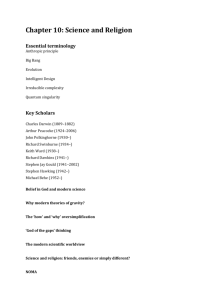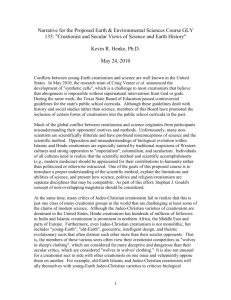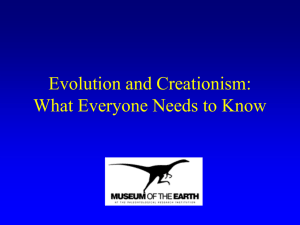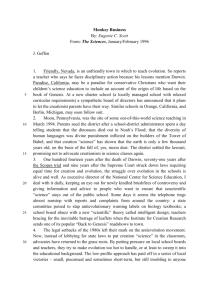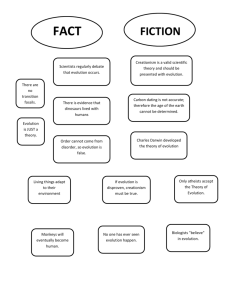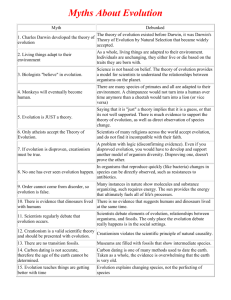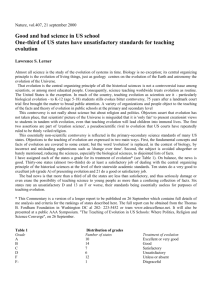Powerpoint Slides - University of Calgary
advertisement
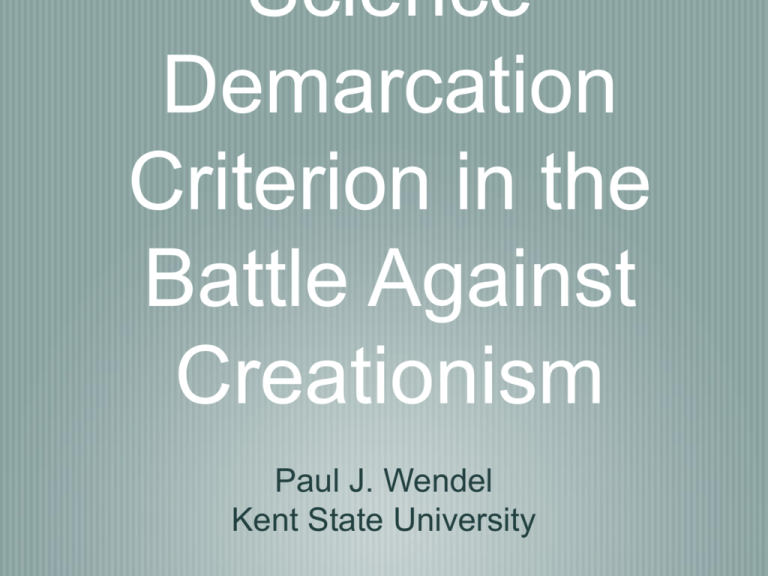
Science Demarcation Criterion in the Battle Against Creationism Paul J. Wendel Kent State University “Young-earth” Creationism “Young-earth” creationists believe: that the universe and all living things were created in six 24-hour days about 6,000 years ago “Young-earth” creationists believe: that Darwinian evolution never happened “Young-earth” creationists believe: that a worldwide flood deposited most of the geologic column From bibleuniverse.co “Young-earth” creationism Young-earth creationism has become the dominant form of creationism in the United States (Numbers 1992). The Creation Museum The 50,000 square foot “Creation Museum” opened in northern Kentucky in May 2007 at a cost of $28 million. From creationiwiki.org/AiG The Creation Museum emphasizes the young-earth creationists belief that dinosaurs and humans lived together AP Photo by Ed Reinke The Creation Museum argues that earth antiquity and evolution are incompatible with Christian belief. AP Photo by Ed Reink Intelligent Design argues that biological structures such as the bacterial flagellum, or biological processes such as the blood-clotting cascade, could not have evolved because removal of one part disables the whole, i. e. they are “irreducibly complex.” Intelligent Design argues that “irreducibly complex” structures must have a Designer. typically silent on the age of the earth, Noah’s flood, dinosaurs, etc. avoids explicit religious references. The Legal Landscape Tennessee v. Scopes (1925) Tenessee’s Butler Act (1925) prohibited all state-supported schools from teaching any alternative to the Biblical creation story, including evolution. Tennessee v. Scopes (1925) Teacher John Scopes intentionally violated the Butler Law and was convicted, but his conviction was overturned on procedural grounds. The Butler Law remained in force until 1967. Epperson v. (1968) U.Arkansas S. Supreme Court overturned Arkansas’s Rottenberry Act of 1928, which outlawed teaching human evolution. The Court ruled that the Rottenberry Act violated the Establishment Clause of the first amendment to the U. S. Constitution: “Congress shall make no law respecting the establishment of religion, or prohibiting the free exercise thereof.” Lead to the overturn or repeal of numerous McLean v. Arkansas BOE (1982) Arkansas Act 590 (1981): The Balanced Treatment for Creation-Science and EvolutionScience Act. In an effort to avoid Establishment Clause conflict, the Arkansas legislature attempted to present creationism as “science” rather than religion. However, the religious content of the act was fairly transparent. McLean v. Arkansas •From Act 590: BOE (1982) •“Creation-science includes the scientific evidences and related inferences that indicate: (1) Sudden creation of the universe, energy, and life from nothing; (2) The insufficiency of mutation and natural selection in bringing about the development of all living kinds from a single organism; (3) Changes only within fixed limits of originally created kinds of plants and animals; (4) Separate ancestry for man and apes; (5) Explanation of the earth’s geology by catastrophism, including occurrence of a worldwide flood; and (6) A McLean v. Arkansas •Judge Overton(1982) ruled that Act 590 violated the BOE Establishment Clause, in part because “creation science” cannot be falsified and therefore is not science: “A scientific theory must be tentative and always subject to revision or abandonment in light of facts that are inconsistent with, or falsify, the theory. A theory that is by its own terms dogmatic, absolutist and never subject to revision is not a scientific theory. The creationist’s methods do not take data, weigh it against the opposing scientific data, and thereafter reach . . . conclusions . . . McLean v. Arkansas BOE (1982) •Instead, they take the literal wording of the book of Genesis and attempt to find scientific support for it . . . [T]hey cannot properly describe the methodology used as scientific, if they start with a conclusion and refuse to change it regardless of the evidence . . .” (McClean v. Arkansas BOE, 1982, pp. 1268-1269). • Kitzmiller v. Dover The Dover, PA school district required that a (2005) disclaimer be read in all high school biology classes. The disclaimer referenced alleged flaws in evolutionary theory and offered Intelligent Design as an alternative. Judge John E. Jones ruled that the disclaimer violated the Establishment Clause, in part because Intelligent Design (ID) is not science. Jones reached this conclusion, in part, by a testability argument: “irreducible complexity” tests the theory of evolution, but the hypothesis of a Designer remains untestable. Therefore ID is not The U. S. National Academy of Sciences Science and Creationism (1999) Science and Creationism (1999) •“Creation science” is disqualified as science on falsifiability/testability grounds: •“[T]he claims of creation science do not refer to natural causes and cannot be subject to meaningful tests, so they do not qualify as scientific hypothesis” (p. ix). Science and Creationism (1999) •“The theory of evolution has become the central unifying concept of biology and is a critical component of many related scientific disciplines. In contrast, the claims of creation science lack empirical support and cannot be meaningfully tested. These observations lead to two fundamental conclusions: the teaching of evolution should be an integral part of science instruction, and creation science is in fact not science and should not be presented as such in science classes” (pp. 1-2). Science and •“Creationism, intelligent design, and other claims of supernatural intervention in the origin of life or of Creationism (1999) species are not science because they are not testable by the methods of science. These claims subordinate observed data to statements based on authority, revelation, or religious belief. Documentation offered in support of these claims is typically limited to the special publications of their advocates. These publications do not offer hypotheses subject to change in light of new data, new interpretations, or demonstrations of error. This contrasts with science, where any hypothesis or theory always remains subject to the possibility Science and •By Creationism contrast, evolutionary theory is testable: (1999) •“The fossil record thus provides consistent evidence of systematic change through time--of descent with modification. From this huge body of evidence, it can be predicted that no reversals will be found in future palentological studies. That is, amphibians will not appear before fishes, nor mammals before reptiles, and no complex life will occur in the geological record before the oldest eukaryotic cells. This prediction has been upheld by the evidence that has accumulated until now: no Science and Creationism (1999) •“[Comparative anatomists] provide important inferences about the details of evolutionary history, inferences that can be tested by comparisons with the sequence of ancestral forms in the paleontological record” (p. 14). Science and Creationism (1999) •“Evolutionary theory explains that biological diversity results from the descendants of local or migrant predecessors becoming adapted to their diverse environments. This explanation can be tested by examining present species and local fossils to see whether they have similar structures, which would indicate how one is derived from the other. Also, there should be evidence that species without an established local ancestry had migrated into the locality” (p. 15). Problems With the Falsifiability Criterion 1. Creationists falsify hypotheses. •In the 1970s and 1980s, creationist Robert Gentry studied radiohalos--scars in granitic rocks attributed to emission of alpha particles by radioactive nuclei. 1. Creationists falsify •hypotheses. Gentry found radiohalos attributed to Polonium 218 (half life ≈ 3 minutes) in solid granite with no visible radiohalos from parent nuclei (e. g. Radon 222). •Gentry concluded that the granite must have been created in solid form in less than 3 minutes. •Therefore granite = 1. Creationists falsify hypotheses. •In the 1980s, the Creation Research Society and the Institute for Creation Research examined Gentry’s data and rejected his conclusions, attributing Polonium radiohalos to nuclear migration. 2. A logical contradiction. •One cannot logically argue that a statement is unfalsifiable and false. Following the McLean decision, Larry Laudan (1982) wrote: •“[Creationist] claims are testable, they have been tested, and they have failed those tests. Unfortunately, the logic of the Opinion’s analysis precludes saying any of the above . . . 2. A logical contradiction. •“Asserting that Creationism makes no empirical claims plays directly, if inadvertently, into the hands of the creationists by immunizing their ideology from empirical confrontation. The correct way to combat Creationism is to confute the empirical claims it does make, not to pretend that it makes no such claims at all” (Laudan, 1982/1996, p. 352). 2. A logical •contradiction. In Science and Creationism (1999), the National Academy commits the same logical error, arguing that creationism is unfalsifiable (previous slides) while cataloging the physical evidence falsifying creationist beliefs such as the young-earth hypothesis (p. 7), a worldwide flood (p. 8), and simultaneous creation of all types of creatures (pp. 20-21). Testable vs. Untestable Features •Stephen Jay Gould (1984) and Judge Jones (in Kitzmiller v. Dover, 2005) separate creationism’s testable claims from its untestable claims. •E. g. Jones argued that “irreducible complexity” is testable, but Intelligent Design is not. •Therefore ID is not science. Testable vs. Untestable •Features Science is also divisible into testable and untestable features: •E. g. String Theory lacks empirical tests, yet most physicists agree that it is science. •E. g. physicists assume that the principles and laws of the universe are simple in some fundamental way, that the same natural laws apply to all parts of the universe, that the same natural laws apply through time, etc. These assumptions are untestable (tests of these principles would rely on these same Testable vs. Untestable •Even where testable, science is non-falsifiable: Features •Lakatos’ (1970): In a scientific research program, a “protective belt” surrounds a “hard core” of scientific tenets. •Kuhn (1970): “It has often been observed . . . that Newton’s second law of motion, though it took centuries of difficult factual and theoretical research to achieve, behaves for those committed to Newton’s theory very much like a purely logical statement that no amount of observation could refute . . . [S]cientists fail to reject paradigms when faced with anomalies or counterinstances. They Additional Demarcation Criteria Tentativeness Robert Merton’s Norms (universalism, communism, disinterestedness, organized skepticism) Additional Demarcation Criteria Methodological Naturalism Cartoon by Sidney Harris A Wittgensteinian Alternative to Demarcation Concepts do not need boundaries Game (PI pp. 32-33) Exactness (PI p. 42) Understanding (PI pp. 60-61) Reading (PI pp. 61-70) Being guided (PI p. 70) Carefulness (PI pp. 70-73) Concepts do not need •boundaries “For how is the concept of a game bounded? What still counts as a game and what no longer does? Can you give the boundary? No. . . . (But that never troubled you before when you used the word ‘game’) . . . We do not know the boundaries because none have been drawn. To repeat, we can draw a boundary -- for a special purpose. Does it take that to make the concept usable? Not at all!” (PI p. 33). •The indistinctness or crudeness of a concept can increase its usefulness for thinking or speaking Nature of Science Consensus: Scientific knowledge while durable, has a tentative character. Scientific knowledge relies heavily, but not entirely, on observation, experimental evidence, rational arguments, and skepticism. There is no one way to do science. The history of science reveals both an evolutionary and revolutionary character. (McComas, Almazroa, & Clough, 1 Nature of Science Consensus: •No single unitary definition of science applies to all contexts. •Many overlapping indicators assist in reaching a judgement regarding whether or not any particular practice should be classified as “science.” Is Creationism Science? No. In the absence of a unitary, context-independent definition of science, this conclusion is a judgement Consensus among scientists that creationism is based on: not science Nearly nonexistent publication record of creationism in mainstream scientific literature Creationist abandonment of methodological naturalism Untestable/nonfaslifiable/nontentative aspects
